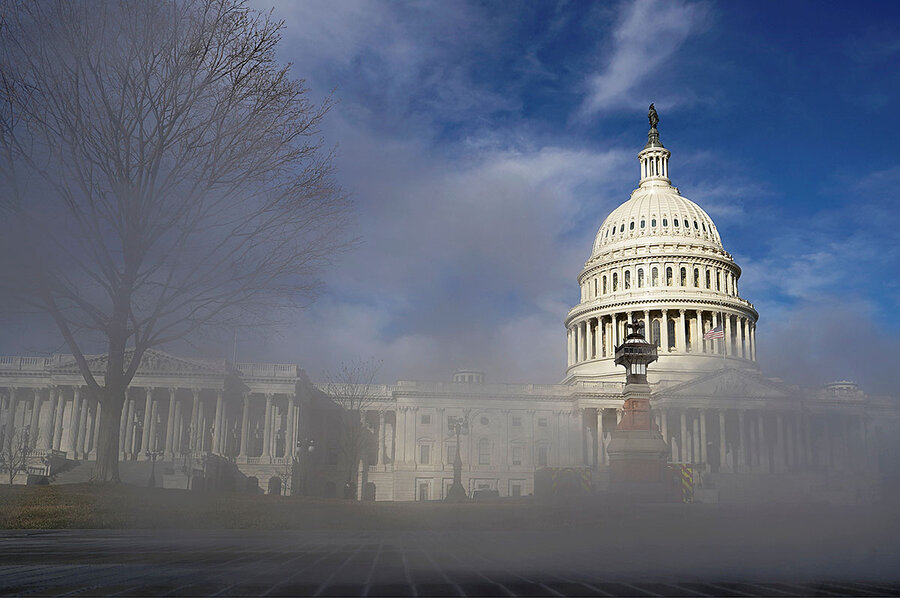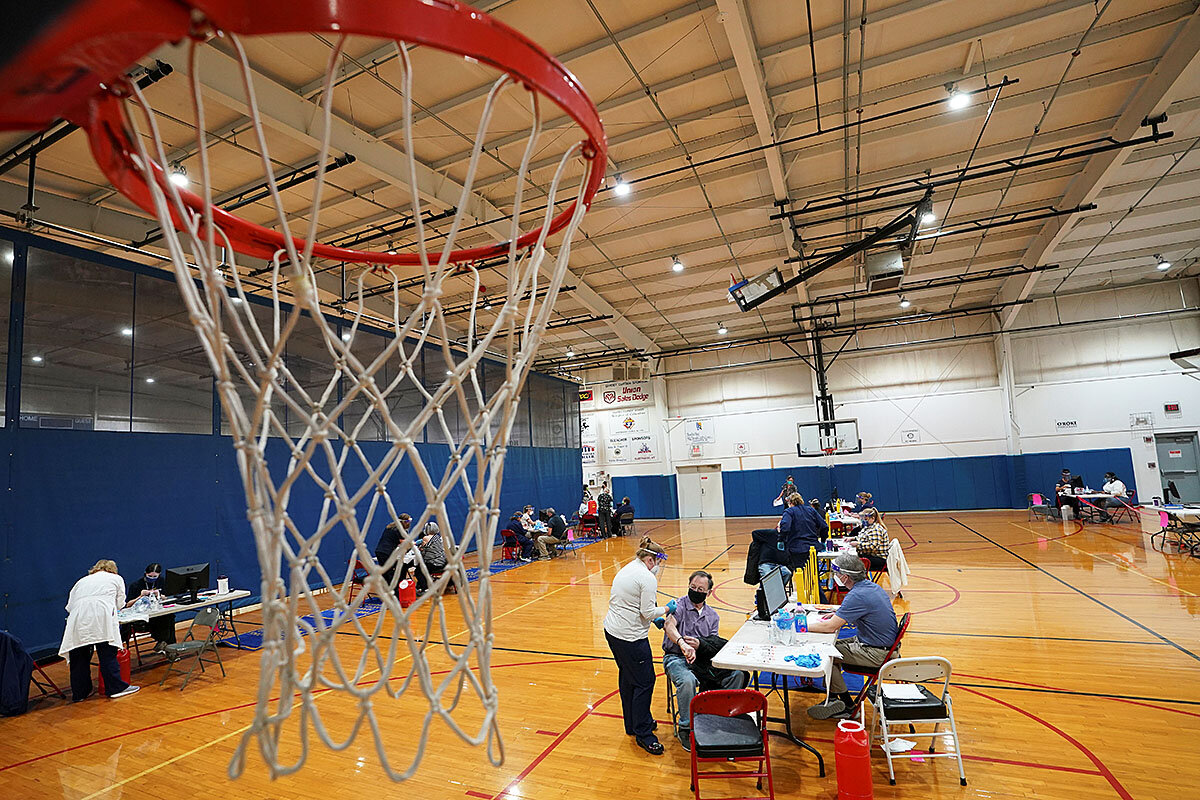Biden’s big COVID-19 aid package: What’s in the bill?
Loading...
| Washington
The Biden administration’s $1.9 trillion COVID-19 aid package is so big that it would qualify as one of the world’s top 10 economies if it were the annual output of a country.
President Joe Biden, White House officials, and congressional Democrats say the package, known as the American Rescue Plan Act, is urgently needed to curb the spread of COVID-19 and help individuals, families, and businesses get back on their feet.
As President Biden was laying out his rationale for the plan, most Republicans agreed on the need for new spending on steps from vaccination to stimulus payments for Americans who have been hit hard economically. But GOP lawmakers differ on the size of the package.
Why We Wrote This
The latest U.S. coronavirus relief bill is massive and moving through Congress on party-line votes. So it’s worth taking a close look to learn what’s in the bill. Stimulus payments and public health are just the start.
A group of 10 Republicans went to the White House to present President Biden with a plan that would cost less than half of the current bill, but the administration and congressional Democrats have resisted scaling back their plan. Since House Democrats have used a process called budget reconciliation to push the bill through Congress, it would need only 51 votes in the evenly divided Senate instead of the 60 normally needed to pass legislation. If all 50 Democratic senators agree to the measure, Vice President Kamala Harris could provide the tie-breaking 51st vote.
Here’s a look at some highlights of the package, showing each category’s approximate percentage of the total package, based on an analysis of the largest ticket items in the bill. The information is drawn from the full text of the bill, estimates from the Congressional Budget Office, and an analysis by the Committee for a Responsible Federal Budget. CBO projections estimate both increased costs and decreased revenues.
On Feb. 26, the House passed the bill 219-212 largely along party lines, with only two Democrats voting against it. Once it gets to the Senate, it will likely undergo significant changes.
Stimulus payments of $1,400 (22% of the total package)
Individuals who meet the following annual income thresholds would receive a one-time payment of $1,400 each: $75,000 for individuals, $112,500 for head of household, and $150,000 for married filing jointly. That will cost the federal government an estimated $422 billion.
Help for state and local governments (18%)
$350 billion in funding for state and local governments, which would be allocated not only according to population as in previous COVID-19 rescue packages, but would also be based on unemployment rates. Republicans say that effectively subsidizes states that imposed strict lockdowns while penalizing states that opted to keep their economies open.
Extending unemployment programs (13%)
The bill proposes extending emergency unemployment programs, which enhance the amount and duration of regular unemployment benefits and extend them to people who would not normally be eligible. According to a CBO estimate, this would cost $242 billion, including:
- $163 billion in federal pandemic unemployment compensation (more generous payments).
- $44.2 billion in pandemic unemployment assistance (for self-employed and other workers not usually eligible).
- $34.5 billion in pandemic emergency unemployment compensation (extended duration of assistance).
K-12 and higher education (9%)
$170 billion for education, of which $129 billion is designated for K-12 schools, which Mr. Biden said could be used to help schools safely reopen, make up for lost learning, and care for the needs of students hardest hit by the pandemic. According to the Congressional Budget Office, the Department of Education has yet to spend most of the $113 billion it has already received in COVID-19 relief, so the CBO estimates that less than 10% of these additional K-12 funds would be spent in 2021.
In addition, the bill provides $7.7 billion to help schools and libraries support distance learning, mainly through telecommunications equipment and services.
Expanded child tax credit, child care tax credit, and earned income tax credit (6%)
According to the CBO, these benefits would cost an estimated $108.4 billion, including:
- $89.2 billion child tax credit.
- $19.2 billion earned income tax credit.
Testing, tracing, and vaccines (5%)
The bill includes $92 billion for public health initiatives, including:
- $46 billion for testing and tracing.
- $7.6 billion for public health departments.
- $7.5 billion to plan, promote, distribute, and track COVID-19 vaccines.
- $6.1 billion for Indian health services, including vaccines ($600 million) and testing and tracing ($1.5 billion).
- $5.2 billion for the supply chain for COVID-19 vaccines, therapeutics, and medical supplies.
Pensions (5%)
$86 billion in assistance to support troubled pension funds.
Health insurance (4%)
The largest expenses related to health insurance that the Monitor identified total $81.3 billion, and include:
- $34.2 billion for expanding assistance with paying health care premiums.
- $16.2 billion for increasing Medicaid payments to states for expanding Affordable Care Act coverage.
- $13.5 billion for veterans’ medical care and health needs.
- $9.6 billion for expanding Medicaid coverage for prisoners close to release as well as pregnant and postpartum women for 5 years.
- $7.8 billion for expanding COBRA benefits for people who lose employer health coverage.
Support for children (3%)
Programs totaling $54.3 billion, including:
- $24 billion for child care stabilization funding (through September 2021).
- $15 billion for child care and development block grant funding to states, tribes, and territories.
- $8 billion dependent care assistance.
- $6.3 billion for child care for workers.
- $1 billion for Head Start.
Raise the minimum wage to $15/hour by June 2025 (3%)
The CBO estimates that this would increase the federal deficit by $54 billion over the next decade, and result in the loss of 1.4 million jobs due to the increased cost of hiring workers but also lift 900,000 people out of poverty. In addition, it would cost the federal government an additional $16 billion in interest on its debt.
The Senate parliamentarian ruled Feb. 25 that this measure could not be included in a bill passed by budget reconciliation. Although some progressives are calling to override that ruling, it will likely prevent the minimum wage measure from being included in the Senate version of the bill. House Democrats say they will keep it in their bill, and Senate Democrats are looking for other ways of making good on their campaign promise to raise the minimum wage, possibly by using tax incentives and/or penalties to get companies to pay higher wages.
FEMA funding (3%)
$50 billion is allocated to the Disaster Relief Fund, a portion of which is allocated for funerals related to COVID-19. The federal government would cover 100% of such funeral costs.
Small-business assistance (3%)
The bill allocates $50 billion for assisting small businesses and restaurants, including:
- $25 billion for Restaurant Revitalization Fund, with grants of up to $10 million per entity and $5 million per location.
- $15 billion for Economic Injury Disaster Loans for small businesses.
- $7.25 billion in additional funding for the paycheck protection program for small businesses.
Eviction prevention, housing, and food (2%)
Programs totaling $44.3 billion:
- $19 billion for housing assistance.
- $9.96 billion homeowner assistance fund.
- $5 billion in emergency housing vouchers.
- $4.5 billion for low-income housing energy assistance act.
- $5.8 billion for expanded food assistance through SNAP.
Transportation, not including air travel (2%)
$30 billion to transit agencies, most of which would go to urban areas. The funds can be used to develop long-range transportation plans, statewide transportation plans, and statewide transportation improvement programs.
$2.2 billion is designated for maintaining public transit operations, $1.7 billion is allocated to Amtrak, and $1 billion to provisions of the FAST Act, a 2015 measure to improve surface transportation such as highways, freight, ferries, and bridges.
Airlines and associated contractors (1%)
$14 billion payroll support grants for eligible air carriers.
$8 billion to airports, including for operations, personnel, sanitizing, and debt service payments.
Agriculture (<1%)
$4 billion for food supply chain and agriculture pandemic response.







